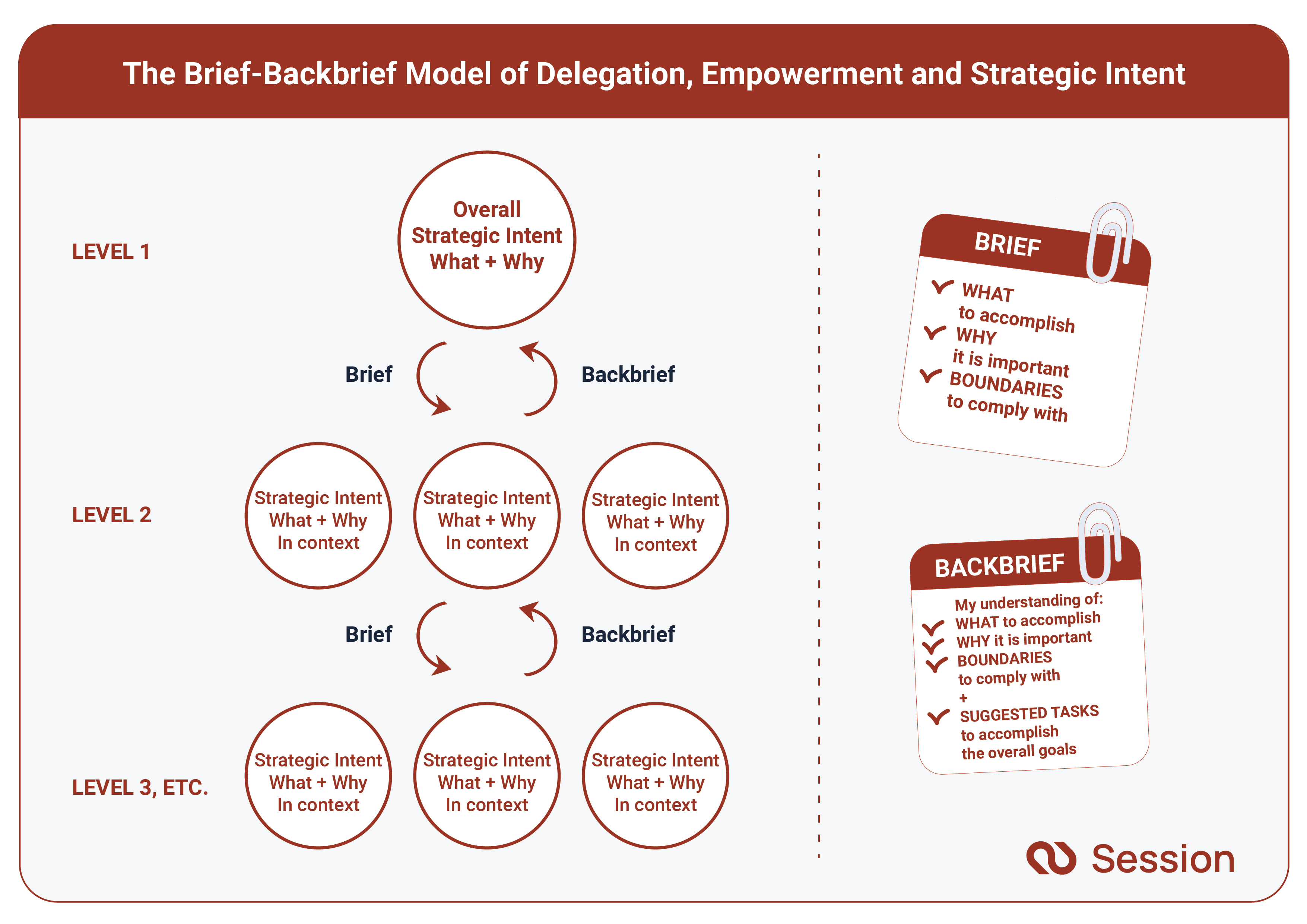De bedste ledere ved, at de skal uddelegere og styrke deres medarbejderes evne til at udføre et godt stykke arbejde. Både for at de selv får frigjort tid, så de kan fokusere på strategiske prioriteter, men også for at give medarbejderne udviklingsmuligheder og mulighed for at udføre deres arbejdsopgaver selvstændigt. Men mange ledere kæmper med at give afkald på magten og med at give ansvar til deres medarbejdere. De kæmper også for at finde tiden til virkelig at udvikle og støtte medarbejderne – hvilket ægte empowerment handler om.
Uddelegering kan være vanskelig, fordi det i sidste ende kræver, at man stoler på andre og giver slip på kontrollen – velvidende at man i sidste ende alligevel bliver holdt ansvarlig for resultaterne. Som en konsekvens har mange ledere en tendens til at være for direkte og give ordrer, når de uddelegerer, for at sikre sig, at tingene bliver gjort efter hensigten. Dette opfattes meget ofte af medarbejderne som manglende tillid og mikromanagement.
Mikromanagement er farlig - det resulterer i lav medarbejder moral, en arbejdskultur, der mangler selvtillid, og ledere, der ikke kan se det store billede - fordi de har alt for travlt med at gøre tingene selv. Hvis dette vækker genklang hos dig, så fortvivl ikke - der er en række måder, hvorpå uddelegering effektivt kan væves ind i strukturen i din organisation og en række måder hvorpå ledere kan blive bedre til empowerment.
"Se dit lederskab som “mindre om at give top-down-ordrer” og mere om udvikling og empowerment og at give medarbejderne mulighed for at træffe de rigtige beslutninger. Mange ledere er fristet til at lede som skakmestre, der stræber efter at kontrollere hvert eneste træk, når de i stedet burde lede som gartnere, der skabes og vedligeholder et levedygtigt økosystem, som organisationen kan trives i." (Stanley McChrystal - General i den amerikanske hær).
Fordelene ved empowerment og uddelegation
"Den øvre grænse for, hvad der er muligt, vil kun stige med hver samarbejdspartner, du bemyndiger til at bidrage med deres bedste arbejde til dine fælles prioriteter. Ligeledes aftager din indflydelse med hvert initiativ, du unødigt holder fast i selv.”, Jesse Sostrin, Harvard Business Review
Empowerment giver utallige fordele. Fra at hjælpe medarbejderne med at blive selvstændige i deres arbejde, til at sætte lederne i stand til at fokusere på overordnet strategisk tænkning og målsætning. Lad os se nærmere på nogle af de mange fordele ved empowerment og uddelegering:
1. Empowerment maksimerer medarbejderens potentiale: Udover at lederen selv får mere tid til at tænke strategisk og langsigtet, så giver empowerment også den enkelte medarbejder mulighed for mere selvstændigt at løse sine opgaver, at udvikle sig og lære nye færdigheder.
2. Empowerment skaber plads til nye ideer: Når lederne beholder kontrollen over arbejdet, og selv håndterer eller er inde over alle detaljerne i et projekt, er det svært for dem at finde tid til nytænkning og udvikling af nye ideer. Derudover går lederen også glip af vigtige perspektiver, ideer og input fra medarbejderne, hvis de fejler med at inddrage medarbejderne. Empowerment bringer medarbejderne med ind i ligningen, og sikrer, at medarbejderne bliver hørt, taget med på råd og inddraget i vigtige beslutninger.
3. Empowerment forbedrer medarbejdernes jobtilfredshed: Undersøgelser peger på, at der er en sammenhæng mellem graden af uddelegering og graden af medarbejdernes overordnede arbejdsglæde samt mellem graden af empowerment og graden af engagement . Det burde ikke komme som nogen overraskelse. Det, at kunne bruge sine styrker fuldt ud (hvilket reel empowerment sikrer) samt det at blive lyttet til, taget seriøst og i betragtning er noget, de fleste medarbejdere ønsker, stræber efter og trives med.
4. Empowerment hjælper dine medarbejdere såvel som organisationen med at vokse: Når arbejdet uddelegeres i hele organisationen, opstår der en mulighed for at udvikle såvel individer som virksomheden både vertikalt og horisontalt. Empowerment sikrer udvikling af den enkelte, men også af teamet og organisationen som helhed.
5. Empowerment og uddelegering er nøglen til at arbejde smartere. Ifølge Gallup, genererer ledere, der udmærker sig i at uddelegere, 33 % højere omsætning. Forestil dig virkningen på din bundlinje, hvis ledere på alle niveauer i din organisation var så gode til at uddelegere og sikre empowerment i dagligdagen.
På trods af ovenstående åbenlyse fordele ved uddelegering og empowerment kæmper mange ledere med at få det til at virke i dagligdagen. Hvorfor er empowerment og uddelegering så svært? Det vil vi se nærmere på i det næste afsnit.
Hvorfor er empowerment og uddelegering så svært?
Det handler om tillid. At uddelegere og udøve ægte empowerment kræver en høj grad af tillid til andre. Tillid kommer ikke naturligt for alle, og det er særligt svært for ledere at opbygge den, hvis de allerede er overbelastede. Lad os tage et kig på følgende ofte sete undskyldninger, som ledere tyr til, når de bliver spurgt hvorfor de ikke i højere grad uddelegerer og gør en indsats for at udøve empowerment:
- "Det er hurtigere, hvis jeg bare gør det selv."
- "Medarbejderne kan ikke gøre det lige så godt, som jeg kan."
- "Der er ikke nogen, at uddelegere til."
- "Jeg stoler ikke på, at medarbejderen er i stand til at gøre det godt på egen hånd."
Lyder det bekendt? Hvis det er tilfældet, spilder du muligvis din tid på aktiviteter af lav værdi, gør livet sværere for dig selv og risikerer i sidste ende at blive stresset og at skade din organisations potentiale til at skalere.
Det kan være ekstremt udfordrende at have og vise tillid, især i organisationer, der er stærkt præstationsdrevne, med mål der kontinuerligt skal nåes. Men denne mangel på tillid resulterer ofte i ledelsesmæssige flaskehalse og manglende smidighed og tilpasningsevne.
Når ledere er bagud med og presset i deres arbejde, har de en tendens til at lægge flere og flere arbejdstimer fremfor at uddelegere - selvom det i længden vil spare dem tid. Som følge heraf er de altid ''tændt'' og deres arbejdsindsats bliver operationel og eksekverende. Det er ikke her, at kreativitet og fremsynethed blomstrer. Uden effektiv empowerment og uddelegering går lederen glip af muligheden for at tænke strategisk, for ikke at nævne glip af muligheden for at udvikle medarbejderne.
Ubevidste fordomme ved uddelegering og empowerment
Selv når lederen lykkes med at udøve empowerment og uddelegering, så viser det sig, at dette ofte sker til medarbejdere, der ligner lederen selv. Med andre ord: Det kommer ikke alle til gode. Dette er bla dokumenteret i en undersøgelse offentliggjort af Journal of Experimental Social Psychology. Ifølge denne undersøgelse har ledere en tendens til at uddelegere til medarbejdere, der tænker, handler og endda ligner dem i forvejen, da dette føles mere psykologisk sikkert og trygt. Som følge heraf uddelegerer ledere ofte til en lille gruppe af ligesindede. Især for ledere, er en af de mest relevante typer fordome, det man kalder “lighedsbias”.
Ifølge SHRM, kommer lighedsbias til udtryk således: ''Folk som mig kan man stole på”. Og hvem vil ikke helst uddelegere til en, man kan stole på? Ligheder kan variere fra etnisk baggrund, religion, race, hobbyer og økonomisk klasse til professionel tilgang og personlighedstyper.''
Denne skævhed i forhold til hvem der uddelegeres til og hvem, der får glæde af empowerment, kan være en trussel imod den overordnede organisation. Den skaber snævre perspektiver og kan også isolere resten af gruppen, som kan føle sig udenfor, uengagerede og i nogle tilfælde - diskriminerede, når intet uddelegeres til dem.
Så hvordan mindsker vi risikoen for lighedsbias? Det er vigtigt at opsøge andre perspektiver end vores. Ledere kan reducere lighedsbias ved at bemyndige og uddelegere opgaver (hvor det er relevant) til medarbejdere, der adskiller sig væsentligt fra dem – og dette er særligt vigtigt, når det kommer til race, etnicitet, køn og økonomisk baggrund. På organisatorisk niveau kan virksomheder også søge professionel træning i at undgå ubevidste fordomme, for at sikre diversitet, og derudover også for at sikre inkluderende ansættelsesprocesser og procedurer.
Kom igang med uddelegering og empowerment
Tiderne ændrer sig. På organisatorisk niveau, efterspørger medarbejderne mere end blot et job. Medarbejdere ønsker respekt, en stærk virksomhedskultur, samt at tage del i beslutninger og ikke blive parkeret ved sidelinjen. Dengang medarbejderne tænkte: ''Jeg er bare glad for at have et job'' er for længst forbi. Den er nu skiftet til en helt anden tilgang mere på linje med "Jeg vil kun arbejde her, så længe jeg finder det meningsfuldt og så længe rollen hjælper mig til at udvikle mig professionelt”.
Med andre ord: Medarbejderne ønsker, at være en del af beslutningstagningsprocesserne, blive lyttet til, og at få mulighed for at lære og udvikle sig: ''Hvordan kan jeg lære og udvikle mig i min nuværende rolle? Hvordan kan jeg bidrage til organisationen? Bliver jeg taget seriøst og lyttet til?’’ Dette er nu oftere reglen end undtagelsen, og den gammeldags top-down ledelsespraksis bliver mere og mere forældet. Beslutningstagning skal tages i frontlinjen - gennem empwerment og uddelegering. På denne måde får du ikke kun en medarbejder, der hjælper dig med at få tingene gjort mere effektivt, du vil også opbygge en læringskultur til gavn for dig og din organisation.
Uddelegering skal imidlertid ikke kun være instruktioner alla ''få venligst dette job ". Det, der er brug for i stedet, er empowerment, ægte empowerment, og det lyder mere som:''Vi skal herhen, kom med et forslag til hvordan vi kan komme derhen, fortæl mig om det, og jeg korrigere, hvis der skal korrigeres, og ellers støtte dig undervejs".
Introduktion til Brief-Backbrief Modellen
Når ledere er tilbageholdende med at uddelegere og udøve empowerment, er det, som tidligere nævnt, ofte fordi man er bange for, at medarbejderen ikke kan finde ud af at løse opgaven tilfredsstillende, eller at tingene løber i forskellige retninger i organisationen. Men ofte løber tingene i forskellige retninger, fordi lederne ikke er tydelige om, hvad de vil have gjort, og hvorfor det er vigtigt.Processen med at give instruktioner efterlader ofte en betydelig mængde plads til fejlfortolkning. Ofte er instruktioner vage eller abstrakte, folk bliver distraheret under briefingen, eller modtageren gør sig måske nogle andre antagelser end den person, der leverer instruktionerne.
Lad os tage et kig på, hvordan empowerment reelt kan finde sted uden at tingene løber af sporet. Brief-Backbrief-modellen, inspireret af Stephen Bungay, kan hjælpe os her. Den er et effektivt værktøj til at styre forventninger, og derved både sætte en klar retning for, hvad vi arbejder hen imod, samtidig med at den giver selvstændighed til medarbejderne til selv at finde gode løsninger.
Med Brief-Backbrief-modellen giver lederen et “brief” om, hvad vi arbejder hen imod og vil opnå, og medarbejderen svarer derefter med en back-brief, der beskriver, hvordan han/hun tænker det kan opnås. Det afgørende er, at lederen ikke giver en instruktion om, hvad han/hun ønsker, at medarbejderen skal gøre, men en kortfattet beskrivelse af, hvad han/hun ønsker opnået. Denne subtile forskel mellem "hvad jeg vil have dig til at gøre" og "hvad jeg vil have dig til at opnå" gør det muligt at sætte en retning uden at fortælle folk, hvad de skal gøre.
Lederen skal dog også kommunikere, hvorfor det er vigtigt. Mennesker søger mening. Når vi forstår, hvorfor noget er vigtigt, kan vi sætte opgaven ind i en sammenhæng, som gør os i stand til at blive mere kreative og løse opgaven bedst muligt. Så når du ikke fortæller folk, hvad de skal gøre, er du nødt til at fortælle folk, hvad der ikke må ske, det vil sige: Hvad er grænserne. Det kan være noget i tråd med "du skal gøre det inden for vores budget" eller "det skal gøres inden tirsdag" eller "det kan ikke gå på kompromis med vores kvalitetsstandarder" osv.
Derfor dækker en god brief:
- Hvad skal vi opnå?
- Hvorfor er det vigtigt?
- Hvad er grænserne?
Medarbejderen afleverer derefter en back-brief (efter at have haft mulighed for at tænke den igennem), der dækker:
Her er min forståelse af:
- Hvad vi skal opnå
- Hvorfor det er vigtigt
- Hvad er grænserne
- Hvad jeg foreslår vi (jeg) gør for at opnå det
Denne enkle rutine er med til at fastlægge forventningerne og sikre, at vi løser de rigtige opgaver. Det giver også lederen feedback på, hvor præcis dennes kommunikation er.
Lederen kan, når han/hun har givet briefen, derefter afgøre, om beskeden blev modtaget korrekt, eller om der er behov for yderligere afklaring. Hvis den gentagne version ikke er den samme som den oprindelige hensigt, skal briefen tydeliggøres og foldes yderligere ud. Denne metode er med til at styrke medarbejderen, uden at lederen opgiver al kontrol. Men det stopper ikke her. Modellen giver også mulighed for refleksion gennem og efter opgavens afslutning: Hvad gjorde medarbejderen? Lærte? Reflekterede over?
Empowerment og strategi
I Stephen Bungay’s HBR-artikel: Sådan får du mest muligt ud af din virksomheds strategi, peger han på kraften i effektiv briefing som et middel til at låse op for skjulte kilder til produktivitet og til at sikre, at medarbejderne i virksomheden både er strategisk alignet og operationelt autonome. Denne metode til empowerment og uddelegering har tjent højtydende organisationer i 2.000 år, med en imponerende historie, der kan spores helt tilbage til den romerske hær. Den bruges også som militær praksis i hele NATO og blev brugt af den preussiske hær i det 19. århundrede.
I betragtning af det uforudsigelige og flygtige forretningsmiljø, vi oplever for tiden, vil virksomheder, der anvender brief-backbrief-modellen være mere tilbøjelige til at fremtidssikre deres strategi. Gennem strategibriefing implementeres en fem-trins tilgang, der kan anvendes fra topledelsen til frontlinje folkene. Det giver ledere og medarbejdere en måde at bevæge sig fra forvirring omkring et komplekst sæt af mål og foranstaltninger til klarhed omkring, hvilke mål hver person skal fokusere på og hvornår. Desuden skubber det beslutningstagning til frontlinjen, styrker tilpasningsevnen, opbygger engagement og sikrer tilpasning.
Trinene er som følger:
(1) angiv din hensigt, hvad du ønsker at opnå og hvorfor,
(2) tegn sammenhængen mellem, hvorfor dette er vigtigt, og den situation din virksomhed eller afdeling er i
(3) fastsæt, hvilke mål der bedst indikerer, om du når dit mål,
(4) definer de opgaver, der ligger i din hensigt, og
(5) definer grænserne
I nedenstående figur har jeg visualiseret processen, som jeg håber du finder nyttig:

Illustration inspireret af Stephen Bungay, lavet af Henrik Kongsbak, illustreret af Agnieszka Ewa
Konklusion
Empowerment og uddelegering er ikke kun noget, der kommer dine medarbejdere og din organisation til gode, det kommer også lederen selv til gode, ved at tage unødig vægt fra skuldrene. Empowerment giver utallige fordele - medarbejderen udvikler sig, får selvbestemmelse og autonomi, og det sætter lederen i stand til at fokusere på den overordnede organisationsstrategi og strategisk tænkning. Det er dog vigtigt at erkende, at det at udøve empowerment og at uddelegere kræver en indsats, for at man undgår skævvridninger i, hvem der uddelegeres til og at man ikke kun giver instruktioner, men snarere indgår i en reel dialog med medarbejderen om det stykke arbejde, der skal laves. Læg dertil vanskeligheden for nogle ledere med at give afkald på kontrollen… Det er altså ikke nogen let bedrift.
Men med brief-backbrief modellen i hånden og din villighed til at prøve det af, lære, udvikle dig selv som leder også, håber jeg, at du er klar til at komme igang. Du vil helt sikkert få gladere og mere engagerede medarbejdere, mere tid til dig selv og den strategiske tænkning, og på sigt, en sundere organisation.










